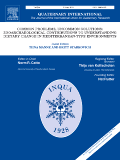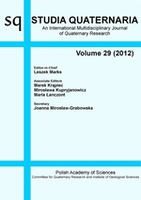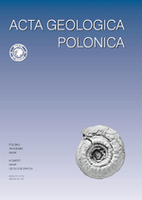
QUATERNARY INTERNATIONAL
Scope & Guideline
Exploring Earth's Transformative Past.
Introduction
Aims and Scopes
- Paleoenvironmental Reconstruction:
Research articles often emphasize reconstructing past environments using proxies such as pollen, diatoms, and sedimentological analyses to enhance our understanding of ecological and climatic changes. - Human-Environment Interaction:
The journal explores how human activities have influenced and been influenced by environmental changes, particularly focusing on archaeological findings and anthropogenic impacts on landscapes. - Geochronology and Stratigraphy:
A significant focus on dating techniques, including radiocarbon dating and luminescence methods, facilitates understanding of sedimentary processes and timing of geological events during the Quaternary. - Multidisciplinary Approaches:
The journal encourages a multidisciplinary approach, integrating geology, biology, archaeology, and climate science to provide comprehensive insights into Quaternary research. - Climate Change Studies:
Articles often assess the impacts of climate change over the Quaternary period, providing critical insights into past climate dynamics and their implications for future scenarios.
Trending and Emerging
- Climate Change Impact Assessments:
There is an increasing focus on studies that assess the impacts of climate change on various ecosystems and human societies throughout the Quaternary, driven by global concerns about environmental sustainability. - Human Adaptation and Resilience:
Research examining how human populations have adapted to environmental changes and climatic extremes is gaining traction, reflecting an interdisciplinary interest in anthropology, archaeology, and ecology. - Technological Innovations in Archaeology:
The integration of advanced techniques such as remote sensing, GIS, and isotopic analysis in archaeological studies is a growing trend, allowing researchers to gather more comprehensive datasets. - Holocene Sea-Level and Climate Change Studies:
The journal is increasingly publishing studies focused on Holocene sea-level changes and their implications for coastal communities, driven by contemporary issues related to climate change and rising sea levels. - Paleoecological and Biogeographical Insights:
Emerging research is emphasizing the significance of paleoecological studies in understanding past biogeographical patterns, particularly in relation to human migration and species distribution.
Declining or Waning
- Traditional Archaeological Methods:
There appears to be a waning interest in purely traditional archaeological methods without integrating modern scientific techniques, as the field increasingly favors multidisciplinary and technologically advanced approaches. - Regional Studies with Limited Scope:
Research focusing on very localized or niche areas without broader implications or comparisons to other regions has become less frequent, as the journal leans towards studies that contribute to global understanding. - Static Climate Models:
Static models of climate reconstructions have seen reduced interest, with a growing preference for dynamic models that account for variability and change over time. - Paleoecological Studies with Limited Proxy Data:
Papers utilizing limited proxy data without robust cross-validation or interdisciplinary support are becoming less favored, as the field moves towards comprehensive, multi-proxy approaches.
Similar Journals

Studia Quaternaria
Fostering global discourse in Earth-Surface Processes.Studia Quaternaria is a leading academic journal published by the Polish Academy of Sciences, Institute of Geological Sciences, specializing in the dynamic fields of Earth-Surface Processes and Geology. With an ISSN of 1641-5558 and an E-ISSN of 2300-0384, this journal has been a prominent platform for scholarly discourse since its inception in 2000. Operating under the open-access model, it aims to disseminate high-quality research that is accessible to a global audience. Studia Quaternaria holds a Q3 ranking in both relevant quartiles as of 2023, indicating its commitment to advancing knowledge in its disciplines despite centering in competitive academic environments. With its publications indexed in Scopus, the journal remains a valuable resource for researchers, professionals, and students looking to stay abreast of innovations and discoveries in Earth-Surface Processes and Geology. Encompassing a broad scope of studies, the journal represents an essential contribution to the geological sciences, fostering a deeper understanding of our planet's changes and processes.

HOLOCENE
Exploring the Interactions of Humanity and Nature.HOLOCENE is a leading academic journal published by SAGE Publications Ltd that serves as an essential platform for researchers and scholars in the fields of archaeology, earth-surface processes, ecology, and paleontology. With an impressive Q1 ranking in prominent categories like Archaeology, Earth-Surface Processes, and Paleontology, this journal is dedicated to disseminating high-quality research that examines the dynamic interactions between humans and their environment throughout the Holocene epoch. Released biannually, it covers innovative studies and comprehensive review articles that contribute to our understanding of environmental changes and their implications across various disciplines. Although it does not offer open access, HOLOCENE maintains a robust reputation with an influential impact on the academic community, making it a vital resource for professionals, researchers, and students who aim to expand their knowledge and explore current developments in Earth and environmental sciences. With a commitment to excellence, HOLOCENE continues to shape the discourse in its field from its headquarters in the United Kingdom.

Gondwana Research
Unveiling Earth's Secrets Through Gondwana ResearchGondwana Research is a premier academic journal published by Elsevier, specializing in the field of geology, with a robust focus on the geological history and processes of the Gondwana supercontinent. With an impressive impact factor and ranking as Q1 in the 2023 Geology category, it stands as a leading platform for disseminating high-quality research. The journal features articles that advance the understanding of Earth and planetary sciences, making significant contributions to geological education and research. Researchers will find its curated content particularly valuable, as it encompasses a wide array of topics including stratigraphy, paleontology, and tectonics, all relevant to both contemporary and historical geological inquiries. Given its substantial reach and esteemed standing—ranked 5th out of 321 in its field—Gondwana Research plays a crucial role in fostering scientific exchange among global experts. Located in the United States with publication continuity from 1997 to 2024, this journal consistently attracts submissions from leading scientists, ensuring that its readership is kept at the forefront of geological discovery and innovation.

GEOSCIENCES JOURNAL
Unveiling the Secrets of Our Planet through Rigorous Research.Welcome to the GEOSCIENCES JOURNAL, a pivotal publication in the fields of Earth and Planetary Sciences and Environmental Science, proudly presented by the Geological Society of Korea. Established in 1997, this journal has become a prominent platform for researchers, professionals, and students, offering a rich collection of peer-reviewed articles that explore a diverse array of geoscientific topics. With an impressive Q2 ranking in both Earth and Planetary Sciences and Environmental Science categories for 2023, it stands as an essential resource in the academic community. Though it operates under a traditional subscription model, GEOSCIENCES JOURNAL remains dedicated to advancing knowledge through rigorous research. Addressed from its headquarters in Seoul, South Korea, the journal aims to foster a deeper understanding of geosciences, encouraging innovation and collaboration in tackling today’s environmental challenges.

Paleoceanography and Paleoclimatology
Unveiling the Secrets of Past Oceans and ClimatesPaleoceanography and Paleoclimatology, published by the American Geophysical Union, is an esteemed open-access journal dedicated to advancing the fields of atmospheric science, paleontology, and oceanography. With an impressive Q1 ranking in all these categories for 2023, the journal is recognized for its impactful contribution, housing research that explores the intricacies of ancient oceanic and climatic systems from 2018 to 2024. Researchers benefit from its robust Scopus rankings, placing it among the top publications in both paleontology and oceanography, with ranks of #5 and #21, respectively, showcasing its significance in the academic community. The journal provides a vital platform for groundbreaking studies that address critical questions regarding Earth's historical climate and ocean processes, making it an essential resource for researchers, professionals, and students alike.

QUATERNAIRE
Connecting Geoscientists Through Groundbreaking Research.QUATERNAIRE is a reputable journal managed by the Société Géologique de France, specializing in the realms of Earth-Surface Processes and Geology. This esteemed publication has been a vital platform for scientific discourse since its inception, presenting compelling research and insights from both fields. With a significant impact in the academic community, it currently holds a Q3 quartile ranking in the 2023 Scopus categories, demonstrating its importance in disseminating knowledge related to geological phenomena. Although QUATERNAIRE does not have an open access model, it ensures that critical research is accessible to a wide audience, enhancing collaboration among geoscientists and environmental researchers. Based in France at 77, Rue Claude-Bernard, Paris F-75005, this journal continues to evolve its publication scope, welcoming contributions that delve into the intricacies of Earth's processes from 1990 to 2024. Researchers, professionals, and students alike will find valuable resources and inspiration within its pages, contributing to a deeper understanding of our planet's past and present.

Journal of Earth Science
Innovating research for a changing planet.Journal of Earth Science, published by the China University of Geosciences, Wuhan, is a leading journal in the field of Earth and Planetary Sciences, recognized for its significant contributions to the understanding of geological processes and environmental challenges. With an impressive Q1 ranking among Earth and Planetary Sciences journals and a strong position at Rank #39/195 in Scopus, this journal not only showcases high-quality research but also serves as a crucial platform for disseminating innovative findings, spanning a broad spectrum of topics from geophysics to climate change. The journal adopts an open access model, which enhances the visibility and accessibility of research articles published from 2009 to 2024, thereby facilitating collaboration and knowledge sharing among the global scientific community. With its commitment to advancing geosciences, Journal of Earth Science is invaluable for researchers, professionals, and students alike, eager to stay informed and contribute to ongoing discussions in this dynamic field.

STRATIGRAPHY AND GEOLOGICAL CORRELATION
Innovating the Science of Stratigraphy and CorrelationSTRATIGRAPHY AND GEOLOGICAL CORRELATION is a prominent scholarly journal published by PLEIADES PUBLISHING INC, featuring a dedicated focus on the fields of geology, stratigraphy, and paleontology. With ISSN 0869-5938 and E-ISSN 1555-6263, this journal has been disseminating significant research findings since its inception in 1994, continuously contributing to the academic discourse through 2024. Despite not currently offering open access, its relevance is underscored by its Category Quartiles for 2023, where it has established itself as Q3 in Geology and Paleontology, and Q2 in Stratigraphy. STRATIGRAPHY AND GEOLOGICAL CORRELATION ranks #29 out of 55 in Stratigraphy and #186 out of 321 in Geology according to Scopus metrics, positioning it within the competitive landscape of Earth and Planetary Sciences. Researchers, professionals, and students are invited to engage with the journal’s content to deepen their understanding and foster innovation within these critical areas of study.

ACTA GEOLOGICA POLONICA
Transforming geological discussions into impactful knowledge.ACTA GEOLOGICA POLONICA is a distinguished journal published by the Polska Akademia Nauk, in collaboration with the University of Warsaw's Geology Department. Since its inception, it has served as a vital platform for disseminating innovative research in the field of Geology, reflecting a commitment to advancing scientific knowledge in Earth and planetary sciences. With an ISSN of 0001-5709 and an E-ISSN of 2300-1887, this journal provides a rigorous review process and is classified in the Q3 quartile for Geology as of 2023, indicating its growing influence in the discipline. Despite not being open access, the journal facilitates meaningful contributions that span a range of geological topics from fundamental research to applied sciences, thereby enriching the academic landscape. Researchers, professionals, and students alike are encouraged to engage with the valuable findings and discussions contained within its pages, which continue to shape the future of geological inquiry.

QUATERNARY RESEARCH
Bridging Disciplines to Illuminate Earth's Dynamic History.QUATERNARY RESEARCH, published by Cambridge University Press, is a leading academic journal that focuses on the study of the Quaternary Period, the most recent geological time period. With a strong emphasis on interdisciplinary research, the journal has significantly contributed to our understanding of Earth's dynamic systems and processes, making it an essential resource for researchers and professionals in the fields of Earth and Planetary Sciences, Earth-Surface Processes, and the Arts and Humanities. It is recognized for its high-impact contributions, reflected in its impressive Q1 rankings across multiple categories, including its position as 69th out of 552 in Arts and Humanities and 49th out of 195 in General Earth and Planetary Sciences, showcasing its influence and relevance in the academic community. While QUATERNARY RESEARCH does not provide open access options, it remains a crucial platform for disseminating valuable research findings and fostering scholarly dialogue. The journal's coverage spans from 1970 to 2024, serving as a comprehensive archive of key developments in the field.